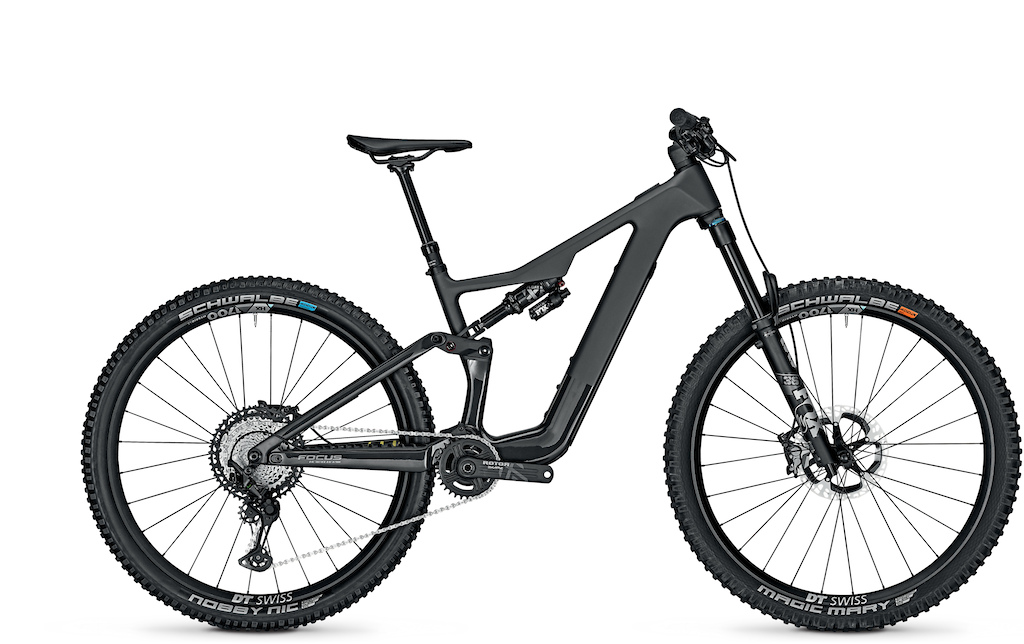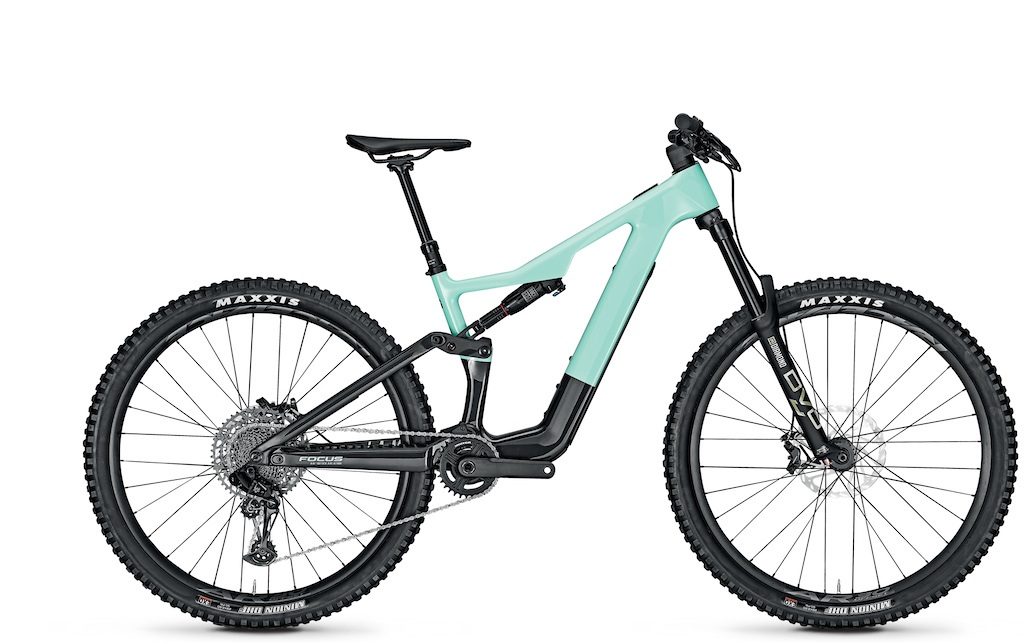I have the second-top model in XL, which weighs 19.05 kg / 42 lb (actual). The top model has a claimed weight of 17.9 Kg, and it is possible to ride without the 2.3 Kg battery, resulting in a weight that wouldn’t look out of place on an enduro bike.
• Carbon-only frame
• 150mm (r)/160 mm (f) travel
• Fazua motor, 60 Nm, 430 Wh battery
• 29″ wheels
• Weight: 19.05 kg / 42 lb (actual, XL )
• Adjustable head angle and chainstay length
• Sizes: S, M, L, XL
• Price: £5,499 / €6,199 to £10,199 / €11,499
• focus-bikes.com
Some e-bikes like the Orbea Rise and Specialized Turbo Levo SL have even lighter claimed weights, but Focus haven’t gone nuts in the pursuit of a headline weight. It still has a removable battery, stout forks and piggyback shocks in some models. It’s also got highly adjustable geometry, 29″ wheels and 150 mm rear travel with 160mm up front.
Motor & Battery
The Fazua motor was chosen because it’s lightweight but still offers enough power (up to 450 W and 60 Nm of torque) to keep up with “full-fat” e-bikes. The 430 Wh battery is bigger than the other lightweight e-bikes (the Orbea Rise carbon has 360Wh and the Levo SL has 320 Wh), and thanks to more efficient use of power and lighter system weight, the range should be comparable to some full-size ebikes with 500 Wh or more.
A remote toggles between the three assistance modes, which are shown with green, blue or purple LEDs on the top tube. The number of LEDs indicates the battery level.
The battery is easily removable. Focus made an ebike with an integrated battery in 2016, but customer feedback told them that people like to remove the battery, so they’ve taken a weight penalty there. On the other hand, there’s no on-bike charging port (you have to remove the battery with an Allen key to charge it). Focus say this decision saves 200 g.
Fazua say they will soon offer a range extender which slots onto the bottle cage bosses. Interestingly, Focus say this will be fully integrated, so there won’t be any need for a cable connecting a bottle-like battery to the charging port, but details are lacking on how this will work.
Frame details
Focus have moved from a single-pivot design to a four-bar linkage for the first time. They say the main reason for doing this is to save weight compared to a solid rear triangle with a shock linkage. Focus aren’t sharing too many details on the suspension kinematics, but the four-bar layout reduces anti-rise compared to the singe-pivot bikes in their lineup, meaning the suspension will sit higher in its travel under braking and arguably is freer to move over bumps as a result. The new layout also allows them to deploy an innovative approach to geometry adjustment.
There’s a flip chip on the chainstay pivot, similar to what you’d find on some Specialized bikes. On its own, this extends the chainstay length and lowers the bottom bracket height, along with knock-on effects to the frame angles. Focus didn’t want this, so they put another flip chip at the point where the seatstay meets the rocker link. This compensates for the change in BB height and frame angles, so the chainstay length can be altered independently of any other variables. The options are 440 mm or 447 mm. You could use one or other to provide four possible geometry configurations, but Focus see them being used together as a chainstay adjuster. The Small and Medium sizes will ship with the shorter setting, and Large and XL the longer one.
Why not just use a single chainstay adjuster at the dropout as many other brands have? I asked Focus and this was their response: “A flip-chip which alters the location of the UDH is not possible because of the clearance which is defined by SRAM. A slidable dropout is quite heavy… That’s why we went for the double flip-chip design. It’s super lightweight and also future-proof for anything SRAM comes up with.”
As if that wasn’t enough adjustment, Focus spec a headset offering two head angle options: 64.5 or 65.5 degrees. Unlike a flip chip, it does this without affecting the other geometry measurements much.
The frame is available in two types of carbon: Max and regular. The difference is about 300 g for a size medium.
Geometry
I used to think of Focus as a laggard in the geometry transformation we’ve seen over the last few years. But now that things have settled down a bit, they seem to have caught up nicely. The Jam² comes in a broad range of sizes with reach numbers from 430 mm to 515 mm. The combination of head angle and chainstay length together make it possible to tweak the wheelbase by up to 20 mm, which alters the stability of the bike far more comprehensively than the token flip chips we’re so used to seeing.
By the way, there is a small typo in the above table – the bottom bracket drop should say 25 mm for all sizes. That corresponds to a BB height of around 345 mm.
Models

Jam² SL9.0 £10,199 / €11,499
Frame: Max Carbon
Fork: Fox 36 Factory, GRIP2
Shock: FOX Float DPS Factory, 3-position
Drivetrain: SRAM XO1 Eagle AXS
Brakes: SRAM G2 Ultimate 200/180 mm
Wheels: Mavic Crossmax X LR, carbon
Tires: Maxxis Dissector, 2.4 Exo
Claimed weight: 17.9 kg

Jam² SL9.9 £7,499 / €8,499
Frame: Max Carbon
Fork: Fox 36 Performance Elite, GRIP2
Shock: Fox Float X Performance
Drivetrain: Shimano Deore XT M8100,11-51
Brakes: Shimano XT, 4 piston, 203/203 mm
Wheels: DT Swiss HX1700 LS, 30-622
Tires: Schwalbe MagicMary, 2.4″ Soft/NobbyNic, 2.4″ SpeedGrip
Claimed weight: 19.2 kg (actual: 19.05 Kg in XL)

Jam² SL 8.8 £6,199 / €6,999
Frame: Carbon
Fork: Fox 36 Rhythm
Shock: Fox DPS, 3-position
Drivetrain: Shimano Deore XT M8100,10-51
Brakes: Magura Storm HC 203/203 mm
Wheels: RaceFace AR30 Offset
Tires: Maxxis Assegai, 2.5,Exo/Dissector 2.4 Exo
Claimed weight: 19.7 kg

Jam² SL 8.7 £5,499 / €6,199
Frame: Carbon
Fork: DVO Diamond E3
Shock: Rock Shox Deluxe Select+
Drivetrain: SRAM NX/SX Eagle, 11-50T
Brakes: SRAM G2 200 / 200 mm
Wheels: RaceFace AR30 Offset
Tires: Maxxis Minion DHF, EXO
Claimed weight: 20.2 kg
Ride Impressions
I haven’t had the Jam² SL for long, but I’ve managed a few rides on familiar terrain in the Tweed Valley.
The Fazua motor was impressive. It’s one of the quietest systems I’ve used, with only a subtle ‘whirr’ on the climbs and no knocking and ratting on the descents. The power comes in smoothly, making it feel very natural and intuitive. There isn’t the grunt of full-power systems, especially when starting off. This definitely makes it easier to manage traction, but sometimes makes it harder to get going on the kind of really steep climbs where a regular bike would have no chance. I like the three modes (any more just gets confusing) and the eco mode is so subtle as to feel almost like riding a regular bike, just on a really good leg day.
I did have a slight issue during a very muddy ride where the remote toggle lever wouldn’t automatically go back to the central position after I’d pushed it up to select a different mode. I also had a problem where it wouldn’t restart after turning off (it switches off automatically if unused for a while). I was able to restart it again after removing and reinstalling the battery. Here is Focus’s response to this feedback: “The bike’s turnoff has to do with a little bug, Fazua will fix it with an update in 4 weeks. Regarding mud on the remote: Yes, they have had some similar rare cases. They believe it happens if the bar’s diameter is a bit on the smaller side. They are working on a solution here. Nevertheless, if you clean it, it should work fine again.“
I did a few climbs with the motor off when riding with people on regular bikes, and it’s very manageable even with the battery installed. The motor doesn’t seem to have a significant amount of drag and the extra weight is probably offset by the faster-rolling rear tire (Schwalbe Nobby Nic) when compared to a typical enduro bike. Equally, I rode with people on full-power eMTBs, and it is possible to keep up, at least for a while. I would have liked a steeper seat angle when riding un-assisted, but with the motor on this doesn’t seem to matter.
When descending, there are a few things I don’t like. I’d prefer more dropper travel than 170 mm (once you get used to 200 mm travel you don’t want to go back), and the rear tire is like a slippery eel in wet conditions. I’d also like to try a taller cockpit (which would require a higher-rise bar) and a shorter stem (which would require a different headset top cap and a long time in the workshop due to the through-stem cable routing).
That aside, I got on with the Jam² SL’s handling straight away. E-bikes weighing north of 25 kg require a recalibration of riding technique, but at 19 kg, the SL feels much more like a regular bike on the descents. The geometry strikes a good balance between stability and agility for my money (I rode it in the slackest, longest setting). It’s easy enough to manual, bunnyhop or hustle through turns, yet doesn’t feel nervous when things get rowdy. In the rough, the weighted chassis still has some of the suspension-flattering quality that reminds you it’s an ebike. But basically, it rides like a bike.
It would make an excellent training tool for enduro racers wanting to get more practice laps on a bike that handles much like their race bike. Equally, for some people, I could see it being their only bike.
Tech Week 2023 is a chance to get up to speed on the latest mountain bike components, apparel, and accessories. Click here to view all of the related content.

